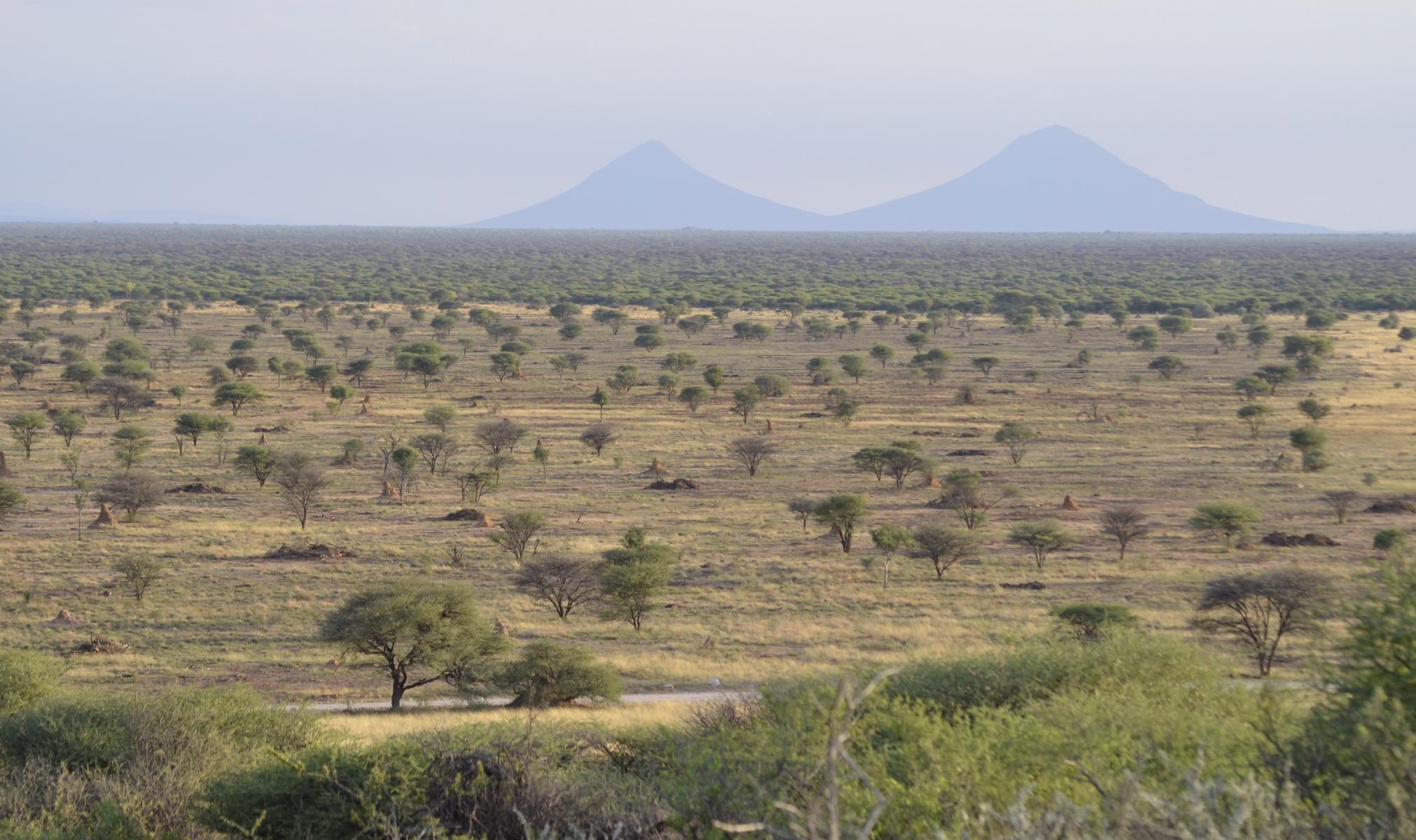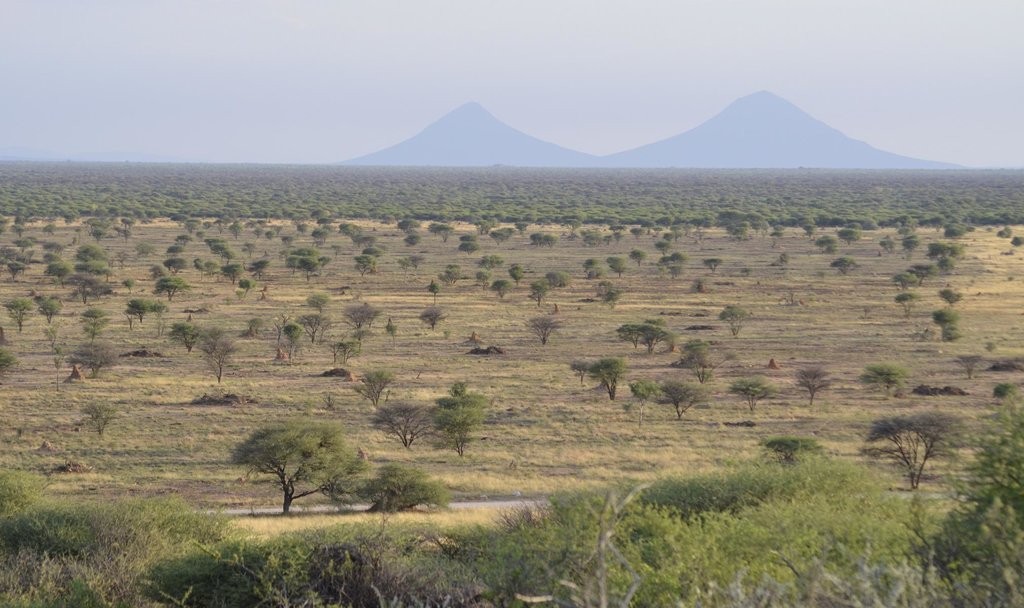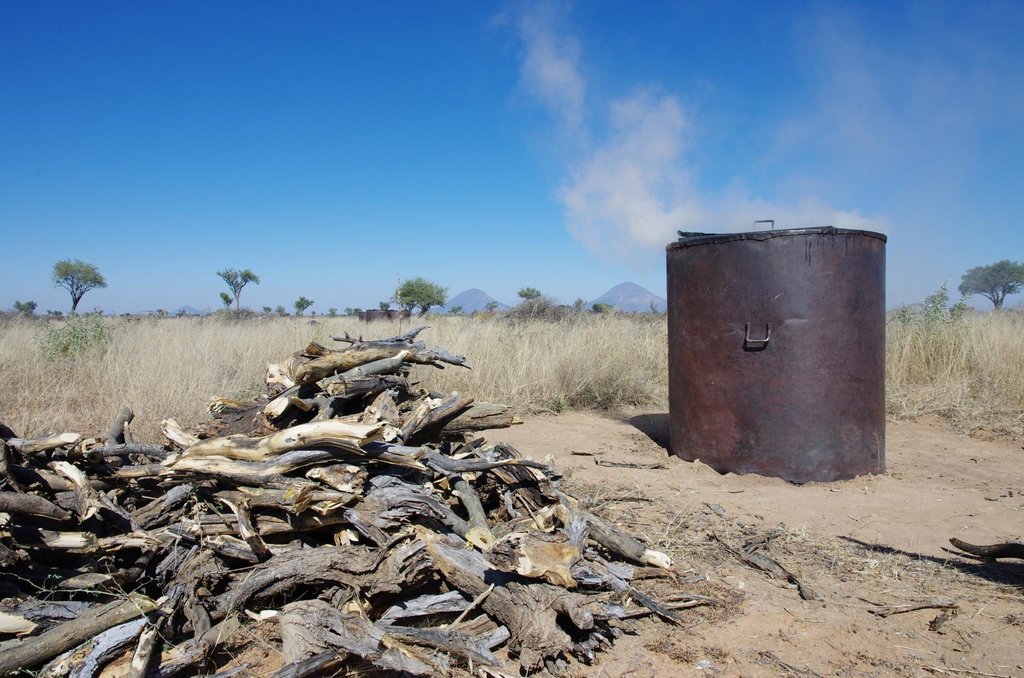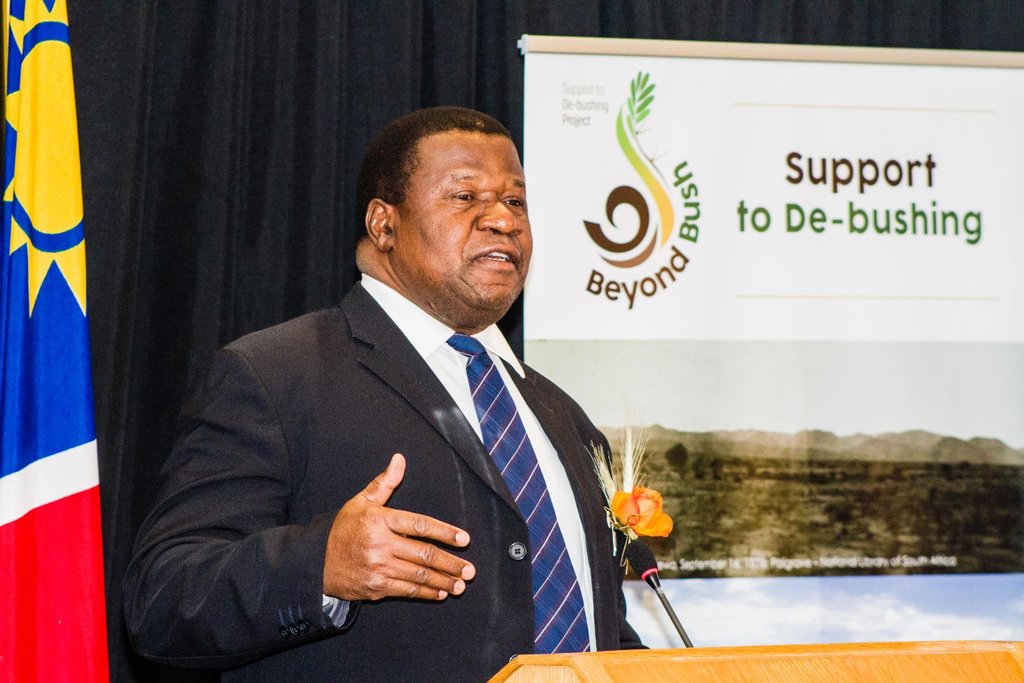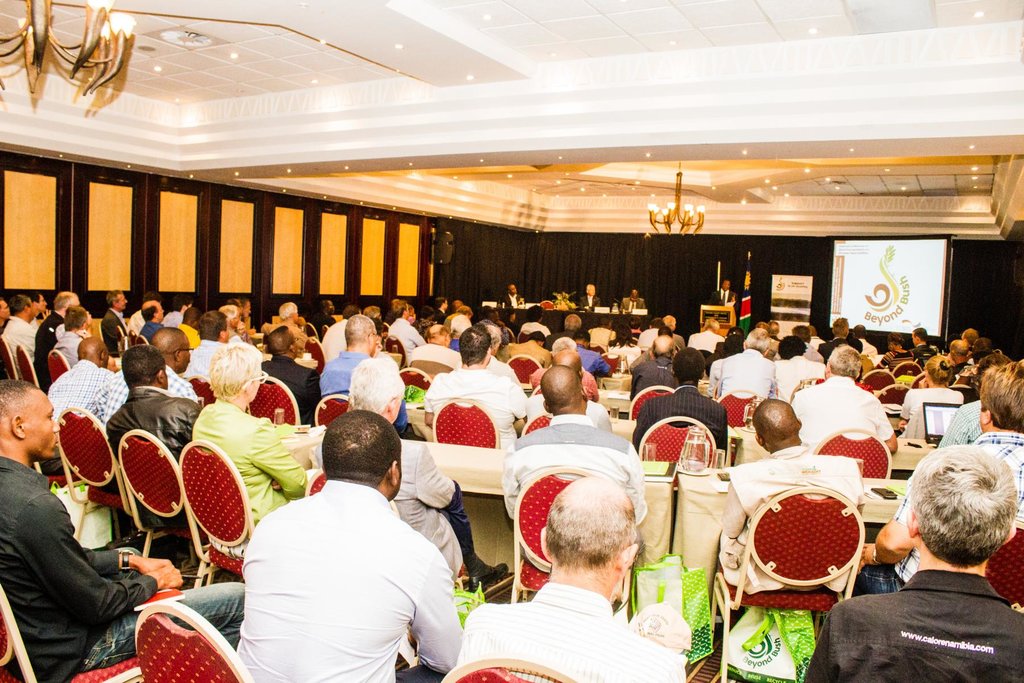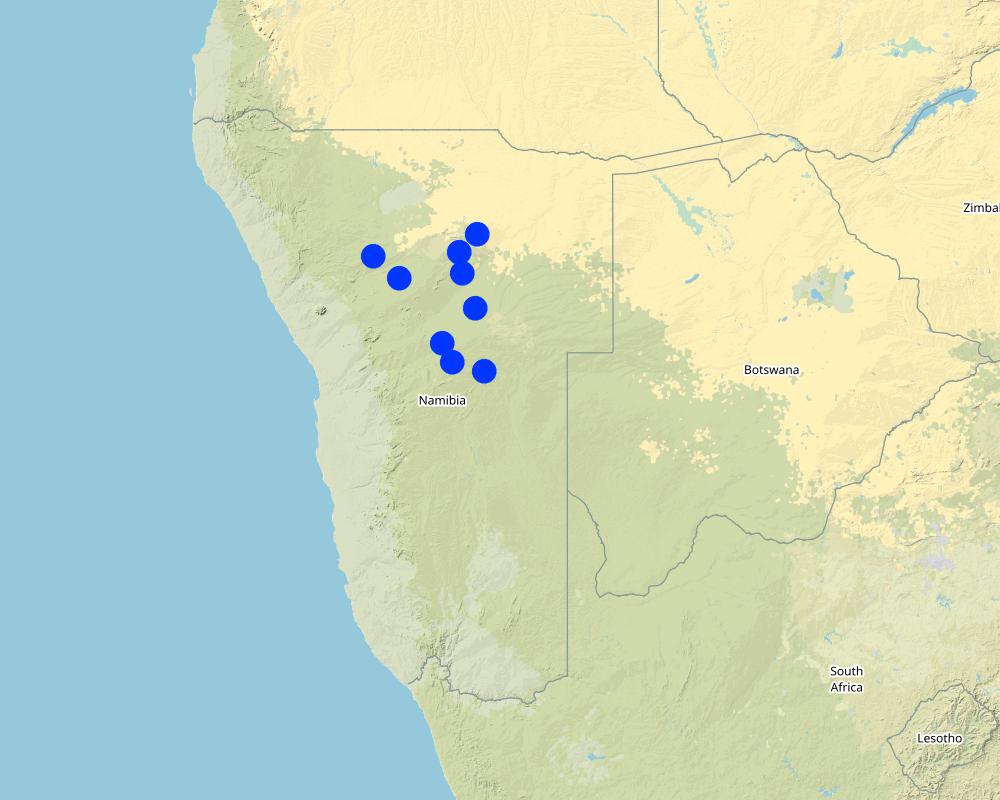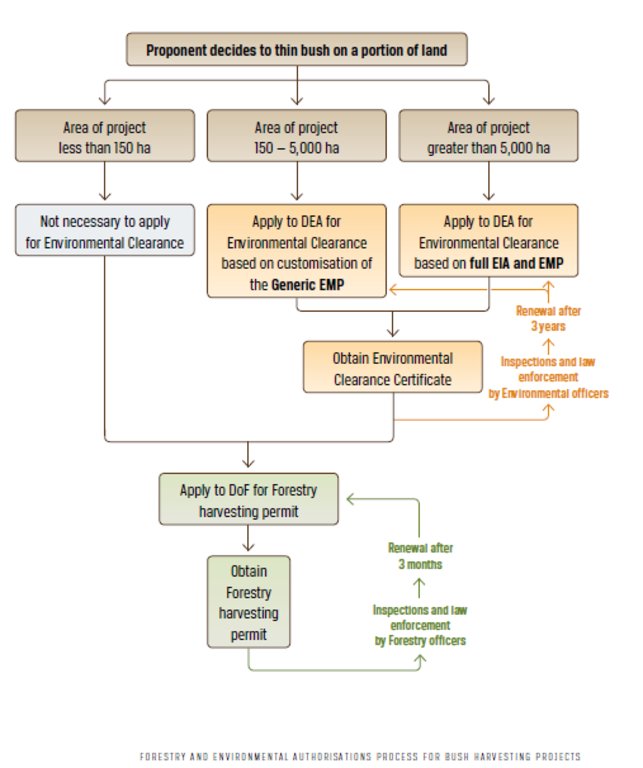Bush Control and Biomass Utilisation [Намибия]
- Создание:
- Обновить:
- Составитель: Johannes Laufs
- Редактор: Asellah David
- Рецензенты: Rima Mekdaschi Studer, Joana Eichenberger
Bush Control and Biomass Utilisation
approaches_2809 - Намибия
Просмотреть разделы
Развернуть все Свернуть все1. Общая информация
1.2 Контактные данные специалистов и организаций, участвующих в описании и оценке Подхода
Специалист по УЗП:
Gschwender Frank
frank.gschwender@giz.de
Deutsche Gesellschaft für Internationale Zusammenarbeit (GIZ)
Название проекта, содействовавшего документированию/оценке Подхода (если применимо)
GIZ Support to De-bushing ProjectНазвание проекта, содействовавшего документированию/оценке Подхода (если применимо)
Book project: Guidelines to Rangeland Management in Sub-Saharan Africa (Rangeland Management)Название организации (-ий), содействовавших документированию/оценке Подхода (если применимо)
Deutsche Gesellschaft für Internationale Zusammenarbeit (GIZ)1.3 Условия, регламентирующие использование собранных ВОКАТ данных
Когда были собраны данные (на местах)?
01/06/2015
Составитель и ответственный/-ые специалист(-ы) согласны с условиями, регламентирующими использование собранных ВОКАТ данных:
Да
2. Описание Подхода УЗП
2.1 Краткое описание Подхода
Public and private stakeholders in Namibia are cooperating in the national Bush Control and Biomass Utilisation programme. There are three components: (1) Creation of an enabling framework, (2) Advisory Services and (3) Value Chain Development.
2.2 Подробное описание Подхода
Подробное описание Подхода:
Namibia is affected by bush encroachment on a massive scale: it affects some 45 million hectares in 9 of the 14 regions. Bush encroachment has lowered the carrying capacity of rangeland by up to two thirds. It further severely reduces biodiversity and limits the recharge of groundwater.
Various factors contribute to the acceleration of bush encroachment. A primary cause is overgrazing: the grass layer loses its competitive advantage and greater infiltration of water and nutrients into the sub-soil results, benefiting bush and tree species. Other factors are the reduction in the frequency of wildfires, and the exclusion of wildlife browsers through fencing for livestock.
The “state-and-transition model” describes how savannah ecosystems are event-driven, where rainfall variation impacts on vegetation growth and its composition. Woody plants establish themselves after dry periods followed by a few wet years, and then maintain themselves by utilizing most of the water. But a savannah can be changed back to its grass-dominated state by management or favorable environmental conditions.
Bush encroachment is accompanied by the loss of perennial grasses, which are replaced by annuals of inferior quality and productivity – thus livestock production becomes precarious and less sustainable.
Despite its negative impacts, the encroaching bush has developed into a huge surplus biomass resource, estimated at about 200 to 300 million tonnes. Measures used to combat bush encroachment create positive opportunities for the Namibian economy, such as the use of the resource for power generation and value chain development in other sectors.
Bush harvesting therefore offers the potential to increase economic growth, employment and energy security, while benefiting agriculture and food production.
In line with national development plans, which promote domestic value addition for local resources, the approach strengthens the restoration of productive rangeland. It triggers and drives large-scale bush thinning activities.
The programme will foster institutional development in the biomass sector and provide support to improve the legal and regulatory framework for the upscaling of bush control. It has three components:
(1) Creation of an enabling framework: harmonization of sector policies and improvement of relevant regulations; strengthening of institutional capacities.
(2) Advisory Services: strengthening of existing farmer outreach services and knowledge dissemination to farmers, businesses and public sector decision makers.
(3) Value Chain Development: identification and piloting of relevant value chains for encroacher bush as a trigger for bush control.
It is implemented through a collaboration of public and private stakeholders. Coordination is ensured through a cross-sector steering committee, which includes the Ministries of National Planning (chair), Agriculture, Environment, Energy, and Industrialisation.
Key outputs of the programme include:
Enabling Environment:
- Strategic Environmental Assessment (SEA)
- Introduction of Harvesting Authorisations Guidelines
- Development of dedicated financial products (loan subsidy schemes).
Institutions:
- Introduction of the De-bushing Advisory Service (DAS)
- Introduction of the Namibia Biomass Industry Group (N-BiG)
- Re-organisation of the Namibia Charcoal Association (NCA).
Knowledge:
- Compilation of baseline data on bush encroachment and bush control
- Technical know-how on value chain technologies and concepts
- Compilation of relevant regulations and environmental principles.
Value Chain Development:
- Piloting of various value chains, including modernized charcoal production, bush based animal feed and household cooking fuel.
2.3 Фотографии, иллюстрирующие Подход
2.5 Страна/ регион/ место, где применялся Подход
Страна:
Намибия
Административная единица (Район/Область):
Bush control is applied across Namibia on many privately owned farms. Activities are most concentrated in the regions of Khomas, Omaheke, Otjozondjupa and Oshikoto.
Более точная привязка места:
Pointers indicate hotspots (e.g. urban centres) around which activities are concentrated. It is not possible to depict each site where bush control is implemented due to the high number of individual activities and because no GIS based mapping has been conducted.
Map
×2.6 Даты начала и окончания реализации Подхода
Год начала реализации:
2014
Если год начала реализации Подхода достоверно неизвестен, дайте примерную оценку:
менее 10 лет назад (недавняя)
Год окончания (Если Подход больше не применяется):
2021
2.7 Тип Подхода
- в рамках проекта/ программы
2.8 Каковы цели/ задачи Подхода
Develop, test and upscale the implementation of bush control technologies in Namibia.
2.9 Условия содействующие применению Технологии/ Технологий в рамках Подхода или затрудняющие его
Социальные/ культурные/ религиозные нормы и ценности
- содействуют
Awareness of the need to implement bush control across all stakeholder groups.
- затрудняют
Low level of cooperation and information exchange.
Наличие/ доступность финансовых ресурсов и услуг
- затрудняют
Limited variety of dedicated/customized financial products available; cost of finance high.
Институциональные условия
- затрудняют
Low level of cross-sector coordination and limited funding sources for sector representative bodies (e.g. associations).
Сотрудничество/ координация действий
- затрудняют
Low level of interaction and knowledge sharing.
Нормативно-правовая база (землевладение, права на земле- и водопользование)
- содействуют
Clear land tenure in commercial areas and suitable concepts in communal areas (e.g. conservancies and community forests).
Программные документы/ руководящие установки
- затрудняют
Low level of policy harmonization across sectors; need to resolve conflicting mandates of relevant authorities (e.g. industrialization vs. resource protection).
Управление земельными ресурсами (принятие решений, осуществление и контроль за выполнением)
- содействуют
Clear governance and management in commercial areas.
- затрудняют
Unclear decision-making processes for income generating projects in communal areas.
Осведомленность в области УЗП, доступность технической поддержки
- затрудняют
Low level of bush control know how among land owners.
Рынки (для приобретения материалов и услуг, продажи продукции) и цены
- содействуют
High national and international demand for woody products.
Объем работ, доступность рабочей силы
- затрудняют
Low level of skills among workers.
3. Участие и распределение ролей заинтересованных сторон
3.1 Заинтересованные стороны, участвующие в реализации Подхода и их роли
- местные землепользователи/ местные сообщества
Commercial farmers, communal farmers, conservancies
Implementation of bush control and/or availing land for bush control and biomass utilisation activities
- организации местных сообществ
conservancies, community forests
Implementation of bush control and/or availing land for bush control and biomass utilisation activities
- эксперты по УЗП/ сельскому хозяйству
Farmer outreach services and independent experts
Dissemination of information and skills development
- ученые-исследователи
Namibia University of Science (NUST), University of Namibia (UNAM)
Complementary research projects
- частный сектор
Namibia Biomass Industry Group (N-BiG), Namibia Charcoal Association (NCA)
Representation of corporates involved in bush harvesting and biomass value addition.
- государственные власти (отвечающие за планирование или принятие решений)
National Planning Commission (NPC)
Ministry of Agriculture, Water and Forestry (MAWF)
Ministry of Environment and Tourism (MET)
Ministry of Mines and Energy (MME)
Ministry of Industrialisation and SME Development (MITSMED)
Policy and strategy development; sector steering; law enforcement, monitoring and evaluation.
- международные организации
Deutsche Gesellschaft für Internationale Zusammmenarbeit (GIZ), KfW, EIB, UNDP
Implementation of bilateral cooperation projects
3.2 Участие местных землепользователей/ местных сообществ на разных стадиях реализации Подхода
| Участие местных землепользователей/ местных сообществ | Перечислите участников и опишите их вовлеченность | |
|---|---|---|
| инициирование/ мотивация | самоорганизация | High awareness and mobilisation within the farming community. |
| планирование | интерактивное | Good participation in public workshops and conferences. |
| выполнение | самоорганизация | Implementation of bush control by individual farmers. |
| мониторинг/ оценка | пассивное | Very limited monitoring and evaluation through individual land owners. |
3.3 Схема реализации (если имеется)
Описание:
Legal and regulatory framework for large scale bush control: the flow chart explains the three levels of categories for the Environmental Clearance process. The categories are as follows:
- Small bush harvesting operations covering less than 150 ha: no environmental clearance required
- Medium bush harvesting operations covering between 150 and 5 000 ha: environmental clearance based on a generic Environmental Management Plan (EMP) is needed
- Large bush harvesting operations of more than 5 000 ha, Environmental Clearance based on Environmental Impact Assessment (EIA) and Environmental Management Plan (EMP)
Abbreviations:
DEA - Directorate of Environmental Affairs, Ministry of Environment and Tourism
DoF - Directorate of Forestry, Ministry of Agriculture, Water and Forestry
EIA - Environmental Impact Assessment
EMP - Environmental Management Plan
ha - hectares
Автор:
GIZ Support to De-bushing Project (2016)
3.4 Принятие решений по выбору Технологии/ Технологий УЗП
Укажите, кто принимал решение по выбору применяемой Технологии/ Технологий:
- все участники как часть процесса совместных действий
Поясните на чём было основано принятие решений:
- анализ подробно описанного опыта и знаний по УЗП (принятие решений на основе подтвержденных фактов)
- результаты исследований
- личный опыт и мнения (незадокументированные)
4. Техническая поддержка, повышение компетенций и управление знаниями
4.1 Повышение компетенций/ обучение
Проводилось ли обучение землепользователей/ других заинтересованных лиц?
Да
Укажите, кто проходил обучение:
- местный персонал/консультанты
Тип обучения:
- в ходе работы
- опытные участки
- общие собрания
Рассматриваемые темы:
- Environmental and forestry policy and policy emplementation (training for government officials from regional offices)
- Implementation of bush control and biomass processing (training for farmers and SMEs)
4.2 Консультационные услуги
Есть ли у землепользователей возможность получать консультации?
Да
Укажите, где именно оказываются консультационные услуги:
- в постоянно функционирующих центрах
Описание/ комментарий:
Advisory services through the De-bushing Advisory Service (DAS, www.dasnamibia.org)
4.3 Институциональная (организационная) поддержка
В ходе реализации Подхода были ли организованы новые институциональные структуры или поддержаны уже существующие?
- да, существенно
Укажите уровень, на котором структуры были укреплены или вновь созданы:
- национальный
Опишите организацию, функции и ответственность, членство и т.д.
Launch of
- De-bushing Advisory Service (DAS)
- Namibia Biomass Industry Group (N-BiG)
Re-organisation of
- Namibia Charcoal Association (NCA)
Укажите тип поддержки:
- финансовая
- повышение компетенций/ обучение
- оборудование
- Institutional Development
Подробнее:
Three sector institutions have been supported in order to achieve increased coordination of efforts. The Namibia Biomass Industry Group (N-BiG) is a non-profit association, representing the interest of bush harvesting and processing companies. The De-bushing Advisory Service (DAS) is a national platform for the dissemination of knowledge on the topics of bush encroachment, bush control and biomass utilisation.
The Namibia Charcoal Association (NCA) represents the already well established charcoal production sector. Through a re-organisation process, the association has been strengthended and turned into a fully functioning sector representation.
The three organisations are planned to consolidate their efforts in the near future in order to achieve a better alignment of their mandates and synergies of activities.
4.4 Мониторинг и оценка
Являются ли мониторинг и оценка частью Подхода?
Да
Комментарии:
National Bush Information System
- Scope of bush encroachment
- Scope of bush control activities
- Success rate of bush control methodologies, incl. secondary impacts (employment)
Если да, будет ли данный документ использоваться для мониторинга и оценки?
Нет
4.5 Научные исследования
Были ли научные исследования частью Подхода?
Да
Укажите темы исследований:
- экономика / маркетинг
- экология
- технология
Напишите подробнее и назовите тех, кто выполнял исследования:
Collaboration with scientific institutions and networks on:
- Identification and development of suitable technology
- Correlation with ecosystem services, e.g. grounwater recharge and biodiversity
- Identification of market for bush based products.
5. Финансирование и внешняя материальная поддержка
5.1 Годовой бюджет мероприятий по УЗП в рамках Подхода
Если точный годовой бюжет неизвестен, укажите примерный диапазон затрат:
- > 1 000 000
Комментарий (например, основные источники финансирования/ ключевые доноры):
Pooling of resources between national government, international donors and private sector.
5.2 Финансирование и внешняя материальная поддержка, предоставляемая землепользователям
Предоставлялась ли землепользователям финансовая/ материальная поддержка для применения Технологии /Технологий?
Нет
5.3 Субсидии на отдельные затраты (включая оплату труда)
- нет
Если труд землепользователя был существенным вкладом, укажите, был ли этот вклад:
- добровольный
5.4 Кредитование
Предоставлялись ли в рамках Подхода кредиты на мероприятия УЗП?
Да
Укажите условия предоставления (процент, окупаемость и т.д.):
Commercial loans with grace period of up to 3 years and interest rate of 7-8%.
Перечислите кредитные организации:
Commercial banks: First National Bank (FNB), Agribank
Development Bank of Namibia (DBN)
Environmental Investment Fund (EIF).
Перечислите заёмщиков:
- Individual households/farmers
- Service providers/business
5.5 Другие методы или инструменты стимулирования
Использовались ли другие методы или инструменты стимулирования для продвижения Технологий УЗП?
Да
Если да, поясните:
Development of authorisations guidelines and review of regulations with regard to Environmental Management Plans (EMPs) and Environmental Impact Assessments (EIAs).
6. Анализ влияния и заключительные положения
6.1 Влияние Подхода
Сумел ли Подход расширить возможности местных землепользователей, повысить участие заинтересованных сторон?
- Нет
- Да, немного
- Да, умеренно
- Да, существенно
Increased dissemination of information and exchange between land users on experiences with technologies; stakeholder representation through associations and participation in high level national conferences.
Сумел ли Подход дать возможность принимать решения на основе подтвержденных фактов?
- Нет
- Да, немного
- Да, умеренно
- Да, существенно
Various publications to capture best practices in bush control and biomass utilisation, including farmers manuals.
Сумел ли Подход помочь землепользователям внедрить и поддерживать технологии УЗП?
- Нет
- Да, немного
- Да, умеренно
- Да, существенно
Development of various guidelines
Сумел ли Подход улучшить согласованность действий и повысить рентабельность применения практик УЗП:
- Нет
- Да, немного
- Да, умеренно
- Да, существенно
Improvement of cross-sector collaboration through steering committee.
Сумел ли Подход мобилизовать/ расширить доступ к финансовым ресурсам для применения практик УЗП?
- Нет
- Да, немного
- Да, умеренно
- Да, существенно
Involvement of financial institutions with the aim to develop customised financial products.
Сумел ли Подход расширить знания и возможности землепользователей в применении практик УЗП?
- Нет
- Да, немного
- Да, умеренно
- Да, существенно
Various publications to capture best practices in bush control and biomass utilisation, including farmers manuals.
Сумел ли Подход расширить знания и возможности других заинтересованных сторон?
- Нет
- Да, немного
- Да, умеренно
- Да, существенно
Increase awareness of the opportunity of the biomass resource among public sector stakeholders as well as within the business community.
Сумел ли Подход укрепить сотрудничество между заинтересоваными сторонами/ выстроить механизмы сотрудничества?
- Нет
- Да, немного
- Да, умеренно
- Да, существенно
Through introduction of steering committee, working groups as well as through the strengthening of sector representative bodies/associations.
Сумел ли Подход расширить возможности социально и экономически уязвимых групп?
- Нет
- Да, немного
- Да, умеренно
- Да, существенно
Employment creation in bush control and biomass utilisation, e.g. in charcoal production.
Сумел ли Подход содействать гендерному равенству и расширить права и возможности женщин и девочек?
- Нет
- Да, немного
- Да, умеренно
- Да, существенно
Promotion of dedicated employment opportunities for women, e.g. in charcoal packaging.
Сумел ли Подход улучшить санитарные условия и доступ к водоснабжению?
- Нет
- Да, немного
- Да, умеренно
- Да, существенно
Improved groundwater recharge in bush controlled areas. Research is ongoing and first results indicate a significantly improved infiltration of rainwater into the groundwater. The reduced number of bushes leads to reduced evapotranspiration.
Сумел ли Подход привести к более эффективному использованию электроэнергии/ возобновляемых источников энергии?
- Нет
- Да, немного
- Да, умеренно
- Да, существенно
First biomass energy projects launched (industrial heating) and in preparation (national grid electricity production).
Сумел ли Подход привести к созданию новых рабочих мест/ к расширению возможностей получения дохода?
- Нет
- Да, немного
- Да, умеренно
- Да, существенно
Employment in bush harvesting and processing, especially in charcoal production.
6.2 Основные причины, побуждающие землепользователей внедрять УЗП
- рост продуктивности
Need for bush control in order to increase carrying capacity of land.
- снижение деградации земель
Rehabilitation of land through bush thinning.
6.3 Долгосрочная устойчивость мероприятий в рамках Подхода
Могут ли землепользователи самостоятельно (без внешней поддержки) продолжать применение того, что было реализовано в рамках Подхода?
- да
Если да, опишите как:
Land users have the capacity to implement bush control, either with own means (mainly manual and semi-mechanised bush harvesting) or through the involvement of service providers (mainly fully mechanised bush harvesting for the supply of large-scale off-takers).
6.4 Сильные стороны/ преимущества Подхода
| Сильные стороны/ преимущества/ возможности по мнению землепользователей |
|---|
| Financial viability of bush control through the introduction of value chains (as compared to mere removal of the biomass). |
| Improved access to information and know how. |
| Improved advocacy/ communication with government authorities. |
| Сильные стороны/ преимущества/ возможности по мнению составителя или других ключевых специалистов |
|---|
| Mindshift among public and decision makers from focus on the challenge (bush encroachment) to the opportunities (value addition). |
| Cross-sector cooperation through steering committee. |
| Involvement of private sector as driving force for implementation. |
6.5 Слабые стороны/ недостатки Подхода и пути их преодоления
| Слабые стороны/ недостатки/ риски по мнению землепользователей | Возможные пути их преодоления/снижения? |
|---|---|
| Limited direct (financial) support. | Introdution of incentive schemes. |
| Limited opportunities in remote areas, i.e. when distance to biomass off-takers is too large. | Further development of on-farm solutions (e.g. bush-to-feed). |
| Слабые стороны/ недостатки/ риски по мнению составителя или ответственных специалистов | Возможные пути их преодоления/снижения? |
|---|---|
| Complex programme steering requirements, due to multi-sector relevance. The national programme for Bush control and Biomass Utilisation is currently anchored in the Directorate of Forestry (DoF) of the Ministry of Agriculture. This adequately accounts for the fact that the bush resource is part of the national forestry/biomass resource and its utilisation must be regulated as such. However, this anchoring does not allow for an effective promotion of biomass utilisation (e.g. SME promotion, industrialisation concepts, development of logistics hubs) and innovative end-uses (e.g. development of biomass power plants). For this purpose other line ministries, such as Ministry of Mines and Energy (MME) as well as Ministry of Industrialisation and SME Development (MITSMED) are part of the programme's steering committee. | Establishment of national coordinating body to formalise the current steering committee. |
7. Справочные материалы и ссылки
7.1 Методы сбора/источники информации
- опросы землепользователей
- опросы специалистов/экспертов по УЗП
7.2 Ссылки на опубликованные материалы
Название, автор, год публикации, ISBN:
Baseline Assessment for the De-bushing Programme in Namibia (2014)
Где опубликовано? Стоимость?
GIZ Support to De-bushing Project, www.dasnamibia.org/downloads
Название, автор, год публикации, ISBN:
GIZ Support to De-bushing Project (2016)
Где опубликовано? Стоимость?
Strategic Environmental Assessment of Large-Scale Bush Thinning and Value Addition Activities in Namibia, www.dasnamibia.org/downloads
7.3 Ссылки на материалы, доступные онлайн
Название/ описание:
De-bushing Advisory Service (DAS) Namibia, Resource Section
Адрес в сети Интернет:
www.dasnamibia.org/downloads
Название/ описание:
Namibia Biomass Industry Group (N-BiG)
Адрес в сети Интернет:
www.n-big.org
Название/ описание:
Namibia Charcoal Association (NCA)
Адрес в сети Интернет:
www.ncanamibia.com
Ссылки и модули
Развернуть все Свернуть всеСсылки
Нет ссылок
Модули
Нет модулей


